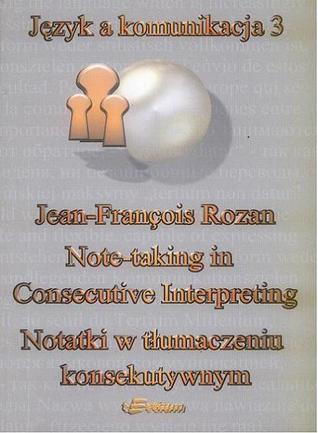The following review of the new English translation of Rozan’s seminal work on note-taking in consecutive, La prise de notes en interprétation consécutive , appeared in the ITI bulletin July-August 2005.
Note-taking in Consecutive Interpreting, Tertium Cracow 2004.

Note-taking in Consecutive Interpreting by Jean-François Rozan
Edited by Andrew Gillies and Bartosz Waliczek ISBN: 83-914764-9-0 Cracow Tertium Society for the Promotion of Language Studies Reviewed by Florence Mitchell
This book revives le Rozan, the slim booklet published in 1956 which presented the note-taking system now used by all consecutive interpreters. Rozan’s text is translated here into English by Andrew Gillies and into Polish by Bartosz Waliczek.
Originally written in French, it will now be accessible to a wider audience. Not too long ago we had a useful chapter on Consecutive interpreting in Roderick Jones’s book (Conference Interpreting Explained, St Jerome 1998), but this is a welcome return to the words of the Master, with just a twist of modernisation.
Taking notes while interpreting is notoriously difficult and yet essential. You might well interpret two sentences from memory, even 3 or 4 if you have your wits about you. But come the fifth sentence you will have forgotten the first and the second. Your brain is constantly working overtime, leaving you with just a faint idea of what it was all about. That’s why a notebook and a pen are an interpreter’s best friends, but they only help if your note-taking system is already properly established. Training systematically may take six months or more in order to reach the point where you become unaware that you are noting something down and simply listen to the ideas behind the words you hear.
Some will ask, is it worth the investment in time and effort? Yes it is, if you are preparing for exams in simultaneous interpreting at the European Commission or at any of the other major international organisations which employ interpreters, as consecutive interpreting tests are invariably the first hurdle. Being able to take notes is also invaluable for freelance conference interpreters who may have to work away from the booths. Be it an afterdinner speech or a press conference, interrupting speakers or asking them to repeat anything is out of the question.
This is a slim book with 60 pages in English and another 60 in Polish. It first came out two years ago, but was not widely available. In the meantime Andrew Gillies has also produced his own book, Note-taking for Consecutive Interpreting – A Short Course, which will be available in September 2005 from St Jerome in its collection ‘Translation Practices Explained’.
Jean-François Rozan interpreted at the UN and taught at the Geneva School for many years, but he left it all to pursue other interests.
ITI bulletin July-August 2005 36 www.iti.org.uk